|
|
Sonar
|
Name:
|
Sonar |
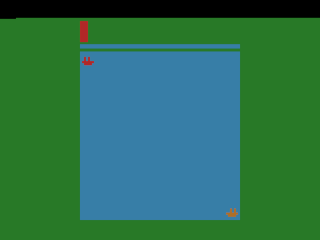 |
| Company: | Atari | |
|
Model #:
|
N/A | |
|
Programmer:
|
Unknown (possibly
Brad Stewart) |
|
| Year: | 1979 |
|
|
Released?
|
No
|
|
|
Notes:
|
Uses stereo sound |
When programmer Brad Stewart (of 2600 Asteroids fame) did
an interview back in 2001, he mentioned working on two
unreleased 2600 games during his time at Atari. One of
these games was Morse
Code Tutor and the other was an unnamed Battleship style
game. While Morse Code Tutor finally surfaced in 2014, the
Battleship game was thought to be lost as Brad didn't have a
copy of it anymore. Fast forward to 2022 when a previously
unknown prototype labeled Sonar was found in the collection of
Jim Snyder (who worked in research and development at Atari in
the early 80's) by Alvaro Arroyo.
Once the game was analyzed it was thought to be Brad's
missing Battleship game. However when shown some video of
the game in action Brad said while it may have looked like a
game he wrote, he didn't recognize the sound and he wasn't sure
if it was indeed his lost Battleship game. Brad also
didn't think that his game got much further than some
preliminary code and a design document. So it would appear
that either this is Brad's lost Battleship game that someone
finished after he wrote some of the code and moved onto another
project, or that this is a completely unrelated game that just
happened to share the same theme. In the early hectic
history of Atari either theory seems equally plausible.
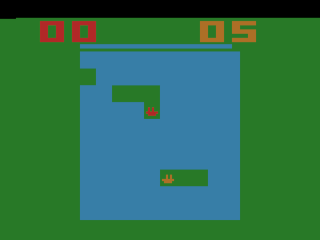
Although Sonar was originally thought to be a 2600 version of Battleship, it's actually a bit different than that. In his interview Brad describes it as a "Version of Battleship" which is a bit more accurate. Since Battleship requires each player to have their own private screen (otherwise each player could see where their opponent has hidden their ships), the programmer had to come up with a different idea for a game where each player shares the same screen. Their solution? Have the computer hide the ships and have each player race around the screen to find them in real time. Each successful hit scores the player 5 points and the player who scores the most points after all the ships have been discovered (as indicated by the blue bar at the top of the screen) wins the game.
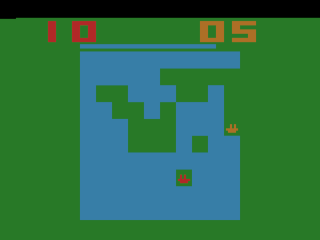
If the above description makes Sonar sound like a button mashing
action game, you'd be wrong. Sonar has four
different options to give the game a bit more
strategy.
Limited Charges - In this variation each ship can only
drop 5 depth charges (indicated by the dashes on the top of the
playfield) before running out. After they run out they
will need to wait until the other player drops all of their
depth charges before their supply is refilled. This
variation allows players to take their time in finding ships.
Miss Penalty - Each time a player bombs an empty square it costs them 2 points.
Invisible - The board isn't marked (the square
doesn't turn green) when a player drops a depth charge .
This makes it harder to remember if you've already bombed a
square or not. Combined with the Miss Penalty variation,
this can be a real score killer.
Mines - Mines are hidden on the board in addition to the ships. If you bomb a hidden mine you lose 5 points.
The matrix below shows the various rules for all 16
variations

So with all the point penalties in the game, how are
players supposed to find ships when mindlessly bombing squares
will quickly decrease their scores to zero? The answer is
right there in the title! When a player is in one square
of a ship they'll hear a sonar sound. This sound helps the
player try and pinpoint the location of each ship.
Depending on the position of the difficulty switch, the sonar
radius is either a complete square around the ship (position A)
or only at the top/bottom/left/right (position B). But how
would each player know which sonar ping was for their ship you
ask? The answer is stereo! The sound for each player
was to come out of separate speakers so they could listen to
their own sonar. In fact Sonar is one of only three games
that was programmed with stereo sound (Combat and Air-Sea Battle
are the other two). This is because the 2600 was
originally supposed to have two speakers in the console itself
where sound would come out instead of going through the TV
(Heavy Sixer models still have mounts for the speakers inside
the case). Atari decided to change this shortly before the
2600 launched, which would explain why only the two launch
titles were programmed with this in mind. However this
doesn't explain why a game programmed in 1979 would make use of
stereo as the sound would come out mono on the TV anyway (unless
the system was specifically modded to play stereo). Not
only that, but unless the speakers were sufficiently far enough
away from each other it would almost be impossible to tell which
sonar sound belonged to which player. This may mean that
programming on Sonar started much earlier than 1979.
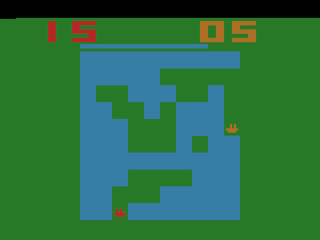
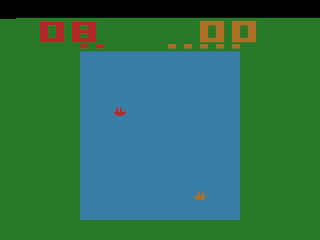
Special thanks to Alvaro Arroyo for finding, dumping, and sharing this prototype and to Thomas Jentzsch for helping figure out how to play the game!
| Version | Cart Text | Description |
| ?/??/79 | Sonar |
Almost complete |
